|
If only 15 pilots were to enter
helicopters in the 2024 Nats, everyone would wonder what in the world has gone drastically
wrong. Heck, in today's contest it probably isn't unusual for a single contestant
to show up with as many as 15 of his own helicopters - one for each type of event
(aerobatics, scale, etc.) and a couple back-ups for each. A mix of homemade, commercial
kits, and modified kits were displayed. Schluter was selling it Hueycobra, and DuBro
had its Whirlybird. Their prototype Hughes 300 showed up, too. In 1972 when
this issue of American Aircraft Modeler magazine was published, 15 pilots
with a total of 17 - including free flight types - helicopters participating in
the Nats was heralded as ground-breaking. How times have changed.
Here's an unrelated question for you: When is the last time you saw a photo in
Model Aviation, Flying Models, or Model Airplane News
of someone smoking a cigarette? In these older magazines, there were occasionally
cover photos (see May 1972 AAM) with a guy having a cigarette hanging out of his
mouth. I've mentioned before the relative dearth of overweight people during those
same times. Maybe that tradeoff has been less smoking and more overweight-ness.
RC Helicopters at the Nats

One can't help wondering why Ernie Huber keeps his lunch in the
box up front. Balances best before the meal. Excellent design won best flight award.
Seventeen RC and Four FF Helicopters Performed at the 72 Nats Always Drawing
a Large Amazed Crowd.
John Burkam
Fifteen helicopterites and 17 machines appeared for the first RC helicopter competition
in the United States on July 27 and 28. Seven of the copters were the popular Du-Bros,
one was a Du-Bro converted to shaft drive, one was a Schluter Hueycobra, one had
Schluter mechanics and an original fuselage. The other seven were scratch-built,
shaft-driven original designs. Most amazing was the fact that all of them were practical,
flyable machines!
Ernie Huber stole the show by flying his original design, belt-driven machine
all over the sky like a Pattern ship under perfect control. He started his Supertigre
60 by pulling a piece of timing belt between a roller and his toothed flywheel.
Then he twisted a knob on the tail which engaged the main rotor. Being more of an
airplane than helicopter pilot, he wasted no time in hovering. He climbed out and
up and began a series of right and left turns, dives and low passes that delighted
the crowd and turned the rest of the beginning RC pilots green with envy. He made
successful hovering landings after both flights and won first place in flying.

Cranking up the workmanship award-winning model is Faye Peoples.
Model based on 2-B from Burkam's WHAI column.
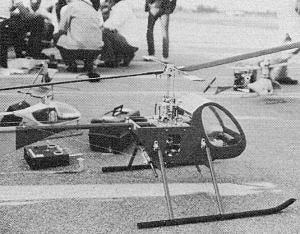
An O&R Compact engine with self-contained clutch, gears,
and pull-cord starter powers Dave Gray's big model. Shows great possibilities, still
being developed, perhaps a DU-Bro kit.

One of Ray Jaworski's two original design models. This one flew
very well until it earned the "worst crash" award.
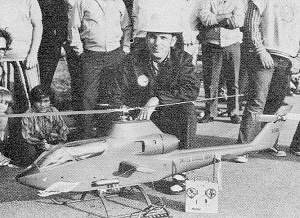
Horace Hagen and his much-flown Hueycobra from the Schluter kit.
It is an inspiring sight and was the only scale design there. He makes flying look
so easy.
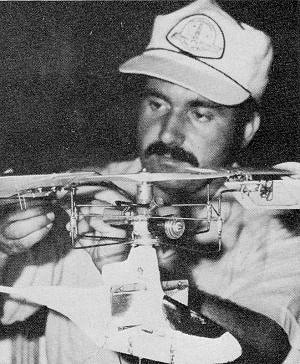
Navy photo of another FF chopper flier, Tony Naccarato, Jr. It
is 049·powered and a fairly simple configuration. Climbs very fast.
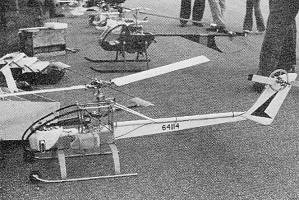
Still improving on his SSP model, Gene Rock made many excellent
and smooth flights with this fourth version of the model just published in AAM.
This model has torque rod driven tail rotor.

In free flight, Dr. Lee Taylor flew this familiar model. Separate
blade sections provide cyclic and collective pitch control.

Dr. Taylor's model on its way up. Was second this year.
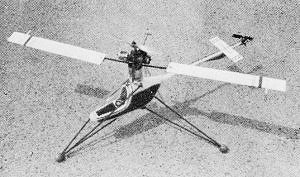
Very stock looking Du-Bro Whirlybird flown by Bob Bentley sports
the much-recommended training gear. This gear almost prevents any turnovers.
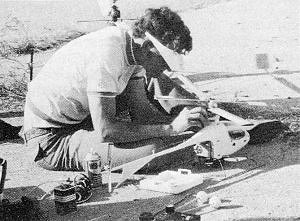
Ed Sweeney brought along a brand-new still-testing shaft driven
conversion of the Du-Bro helicopter. Powered by only a 19 and uses many RC race
car parts. Simple model will be published soon.
Faye Peoples, winner of the workmanship category, flew his original design based
on the 2-B drive system (May 1972 AAM). On his second flight without tether lines,
Faye hovered steadily at altitudes up to 20 feet, thanks in part to the teetering
springs added to his Hiller rotor.
Ray Jaworski also added teetering springs to his Hiller type rotor, and it flew
better than ever before. Ray, not so cautious as Faye, climbed his ship up to about
100 feet and started a left (downwind) turn. As speed increased, more forward stick
was required for forward flight. He made one turn which ended with a swoop to three
feet altitude and another zoom to 30 feet. The next turn really ended with a nearly
vertical dive. Latest word from Ray is that he has nearly completed repairs and
is going to get that little bit of practice which will bring him the complete success
for which he has worked so long and hard.
Gene Rock won first in design and second in flying with his SSP-4, an improved
version of his altitude record holder (August 1972 AAM). Gene "walked" his model
up and down the runway with or against the wind, did climbs, turns, descents under
full control, and picked up the wire hoop with his landing skid. After each of his
two crashes - one due to a near miss with another model, another due to radio interference
- the model was repaired and back in the air in less than half an hour, thanks to
rugged, foldable blades.
Horace Hagen's Hueycobra performed impressively, though perhaps a little too
close to the crowd. Unfortunately, a tail rotor pitch link slipped off during a
hovering turn, causing him to lose power and directional control. Nevertheless,
he had it repaired and back flying in about an hour. Horace won second place for
his beautiful workmanship on the German kit.
Du-Bro helicopters can fly in a wind. All it takes is removal of the
horizontal stabilizer. Bob Bentley, Dave Gray, Chuck Sherman, Bill Phillips and
Mike Scun proved it. Dave Keats proved it so well that he placed third in flying,
(He also picked up one of the hoops with his landing skid.)
Nate Rambo took the Schluter dynamic system and put it in his own original airframe.
Nate hovered well, had a go at picking up the hoop (his helicopter didn't seem to
understand his very expressive gestures), flew forward and backwards and other gentle
maneuvers.
Dave Gray hovered his 14-lb. monster with the O&R gasoline engine, but hadn't
yet advanced to the point of fast forward flight. Nevertheless, it won him second
place for design.
Neatest trick of the meet was performed by Ed Sweeney, who had converted his
Du-Bro helicopter to shaft drive, using a Veco 19 engine, mostly stock parts from
race cars, nose gear fittings and ingenuity. His two-bladed rigid rotor had conventional
airfoil type blades and was controlled and stabilized by a Hiller servo rotor whose
cyclic pitch was controlled by the swash plate. By Saturday, Ed had licked most
of the bugs in his design and managed to fly a full circle and make a landing with
good control and good wind penetration. Think of the implications of this feat!
John Burkam brought his latest helicopter, Square 2-B, but it was not com-pleted
in time to fly.
General Observations: All of the helicopters which flew forward fast had Hiller
type rotors, most of which strongly resembled Dieter Schluter's rotor. Five of the
Hiller rotors had spring restraint about the teetering hinge and flew quite steadily.
Rotors which had single bolt attachment of the blades survived roll-overs, even
crashes. Those which didn't, shattered blades every time they contacted anything.
Everybody seemed to have a good time, made new friends, and learned a lot.
The free-flight helicopters had their day on Thursday in a contest sponsored
by the National Free Flight Society. Tony Naccarato won first place with his new
four-bladed torque reaction job. D. Lee Taylor came in second with his venerable
sport coupe somewhat resembling the Filper helicopter. His and Tony's machines both
obtained their control for turning and flying forward by means of vanes in the slipstream
of the small propeller. Glen Lee's larger two-blader had the engine below, with
the propeller at the bottom of a shroud, some thrust augmentation being thereby
gained. Taylor's and Lee's helicopters have probably won more trophies than any
other helicopters in this country.
All three designs had hingeless but flexible rotors with blades free to pitch
or feather and with balance weights ahead of the leading edge of the blades. Taylor's
and Lee's also had aerodynamic tabs on short booms behind the blade tips for quicker
change in blade pitch for autorotation. This might be an excellent system for use
on RC copters if the blades could be controlled cyclically by some kind of swash
plate. At last auto rotation would be possible, and the hub would be quite simple.
However, test stand experiments by Gene Rock showed that these rotors go ape above
about 400 rpm in a slow version of classical flutter. Viscous damping (thick grease)
on the blade pitch bearings cured that, but there is still the control problem and
the question of forward flight behavior.

Glen Lee's large 15-powered FF model has low disc loading and
so its sink rate in auto-rotation is very slow. Engine is on the main shaft for
torque reaction drive but located below and inside the fuselage.

Nate Rambo starting his ship. It is made from many Schluter helicopter
mechanical parts with Nate's own fuselage.
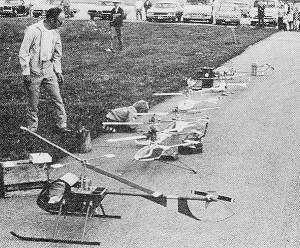
Dave Keats wonders which of all those Whirlybirds is his. Most
of the models at the Nats were Du-Bros.
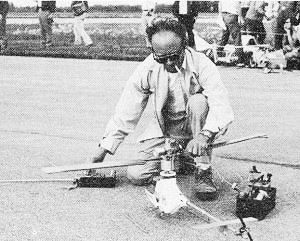
Third place in flying achieved by the always· airborne Dave Keats.
He has become one of the master fliers of the Du-Bro Whirlybird.
Posted August 2, 2024
(updated from original post
on 10/5/2011)
|


